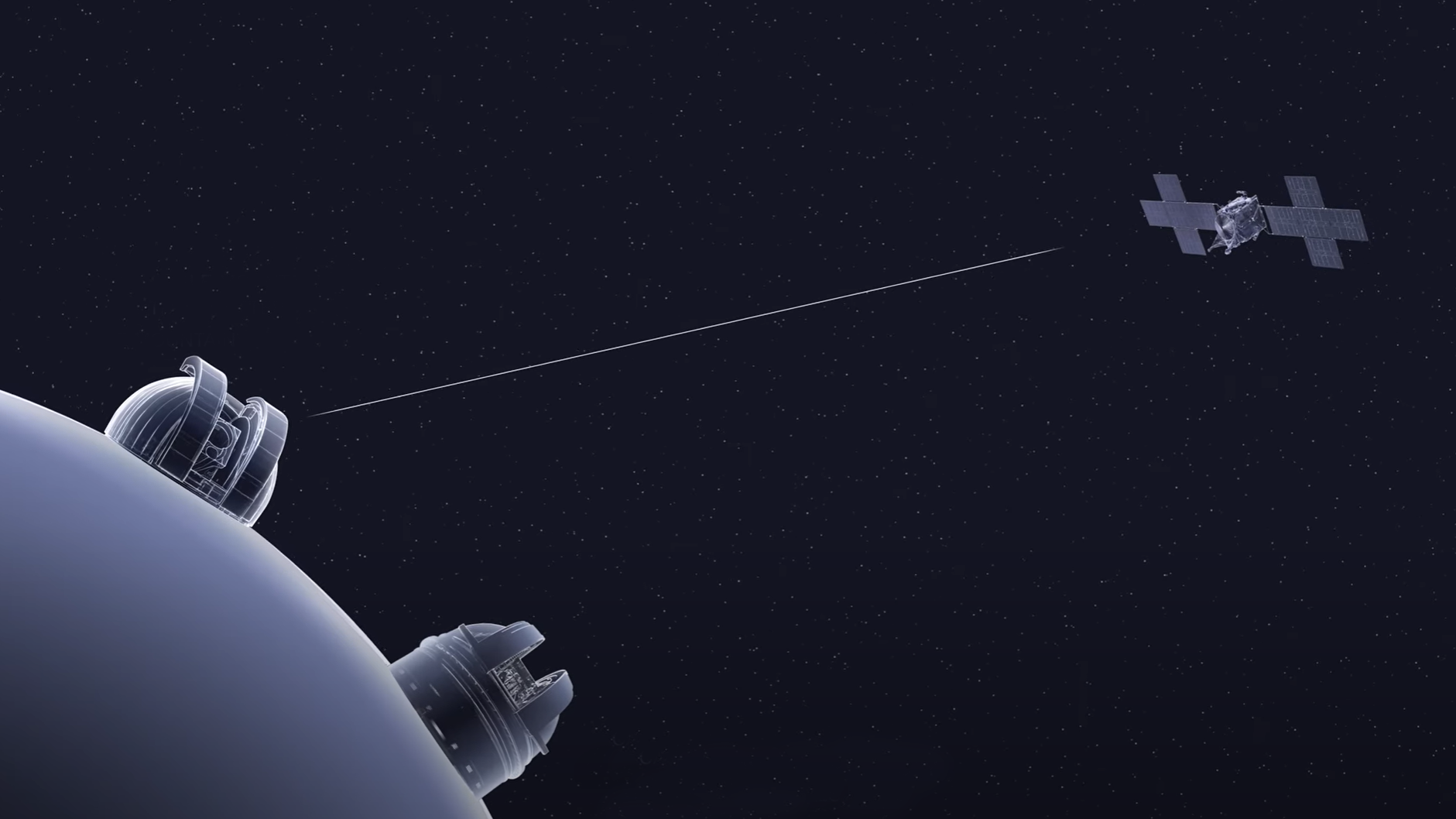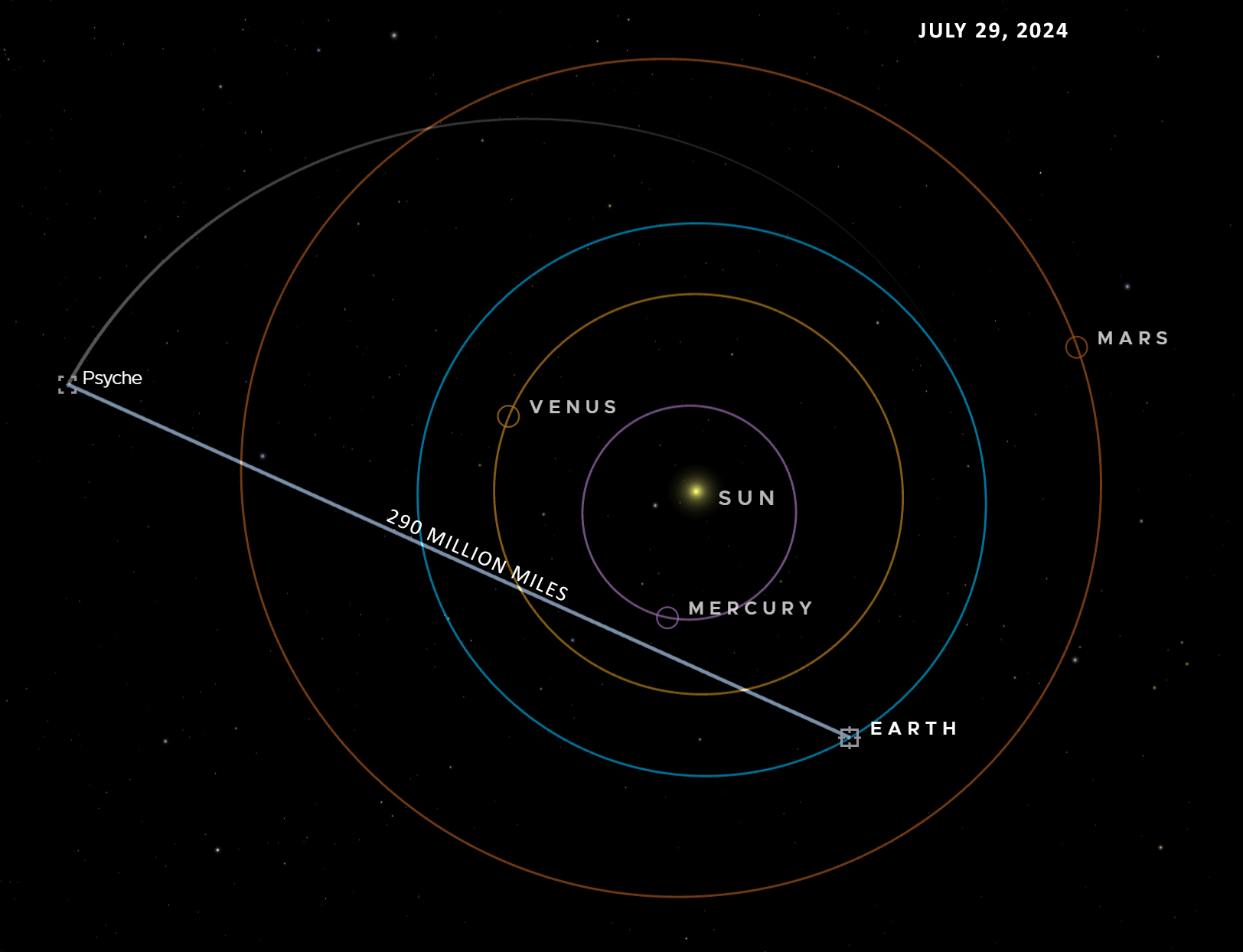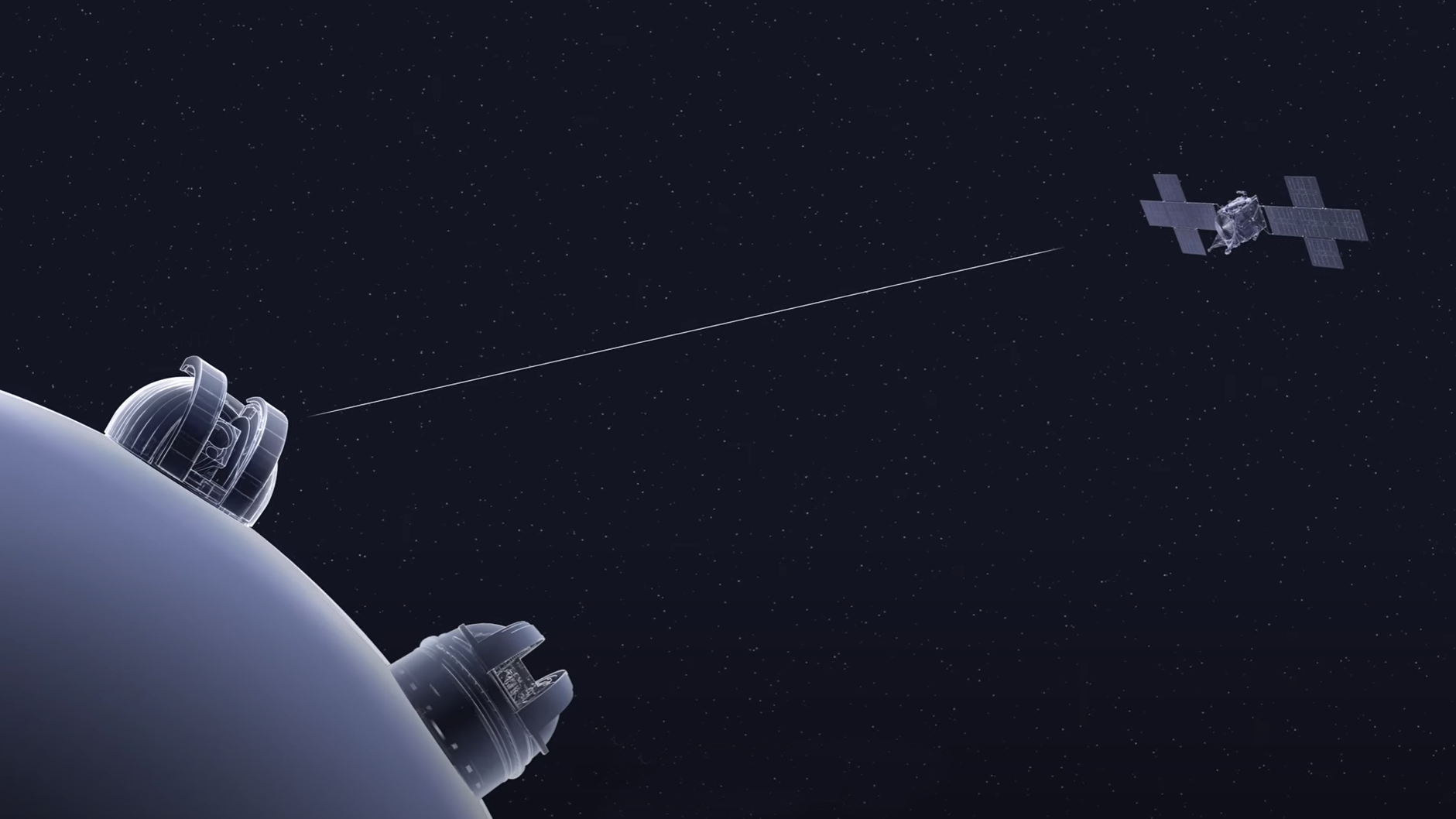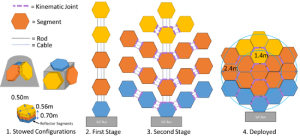5 min read
Preparations for Next Moonwalk Simulations Underway (and Underwater)  NASA’s Psyche spacecraft is depicted receiving a laser signal from the Deep Space Optical Communications uplink ground station at JPL’s Table Mountain Facility in this artist’s concept. The DSOC experiment consists of an uplink and downlink station, plus a flight laser transceiver flying with Psyche.NASA/JPL-Caltech The Deep Space Optical Communications tech demo has completed several key milestones, culminating in sending a signal to Mars’ farthest distance from Earth.
NASA’s Psyche spacecraft is depicted receiving a laser signal from the Deep Space Optical Communications uplink ground station at JPL’s Table Mountain Facility in this artist’s concept. The DSOC experiment consists of an uplink and downlink station, plus a flight laser transceiver flying with Psyche.NASA/JPL-Caltech The Deep Space Optical Communications tech demo has completed several key milestones, culminating in sending a signal to Mars’ farthest distance from Earth.
NASA’s Deep Space Optical Communications technology demonstration broke yet another record for laser communications this summer by sending a laser signal from Earth to NASA’s Psyche spacecraft about 290 million miles (460 million kilometers) away. That’s the same distance between our planet and Mars when the two planets are farthest apart.
Soon after reaching that milestone on July 29, the technology demonstration concluded the first phase of its operations since launching aboard Psyche on Oct. 13, 2023.
“The milestone is significant. Laser communication requires a very high level of precision, and before we launched with Psyche, we didn’t know how much performance degradation we would see at our farthest distances,” said Meera Srinivasan, the project’s operations lead at NASA’s Jet Propulsion Laboratory in Southern California. “Now the techniques we use to track and point have been verified, confirming that optical communications can be a robust and transformative way to explore the solar system.”
Managed by JPL, the Deep Space Optical Communications experiment consists of a flight laser transceiver and two ground stations. Caltech’s historic 200-inch (5-meter) aperture Hale Telescope at Caltech’s Palomar Observatory in San Diego County, California, acts as the downlink station to which the laser transceiver sends its data from deep space. The Optical Communications Telescope Laboratory at JPL’s Table Mountain facility near Wrightwood, California, acts as the uplink station, capable of transmitting 7 kilowatts of laser power to send data to the transceiver.
 This visualization shows Psyche’s position on July 29 when the uplink station for NASA’s Deep Space Optical Communications sent a laser signal about 290 million miles to the spacecraft. See an interactive version of the Psyche spacecraft in NASA’s Eyes on the Solar System.NASA/JPL-Caltech By transporting data at rates up to 100 times higher than radio frequencies, lasers can enable the transmission of complex scientific information as well as high-definition imagery and video, which are needed to support humanity’s next giant leap when astronauts travel to Mars and beyond.
This visualization shows Psyche’s position on July 29 when the uplink station for NASA’s Deep Space Optical Communications sent a laser signal about 290 million miles to the spacecraft. See an interactive version of the Psyche spacecraft in NASA’s Eyes on the Solar System.NASA/JPL-Caltech By transporting data at rates up to 100 times higher than radio frequencies, lasers can enable the transmission of complex scientific information as well as high-definition imagery and video, which are needed to support humanity’s next giant leap when astronauts travel to Mars and beyond.
As for the spacecraft, Psyche remains healthy and stable, using ion propulsion to accelerate toward a metal-rich asteroid in the main asteroid belt between Mars and Jupiter.
Exceeding Goals The technology demonstration’s data is sent to and from Psyche as bits encoded in near-infrared light, which has a higher frequency than radio waves. That higher frequency enables more data to be packed into a transmission, allowing far higher rates of data transfer.
Even when Psyche was about 33 million miles (53 million kilometers) away — comparable to Mars’ closest approach to Earth — the technology demonstration could transmit data at the system’s maximum rate of 267 megabits per second. That bit rate is similar to broadband internet download speeds. As the spacecraft travels farther away, the rate at which it can send and receive data is reduced, as expected.
On June 24, when Psyche was about 240 million miles (390 million kilometers) from Earth — more than 2½ times the distance between our planet and the Sun — the project achieved a sustained downlink data rate of 6.25 megabits per second, with a maximum rate of 8.3 megabits per second. While this rate is significantly lower than the experiment’s maximum, it is far higher than what a radio frequency communications system using comparable power can achieve over that distance.
This Is a Test The goal of Deep Space Optical Communications is to demonstrate technology that can reliably transmit data at higher speeds than other space communication technologies like radio frequency systems. In seeking to achieve this goal, the project had an opportunity to test unique data sets like art and high-definition video along with engineering data from the Psyche spacecraft. For example, one downlink included digital versions of Arizona State University’s “Psyche Inspired” artwork, images of the team’s pets, and a 45-second ultra-high-definition video that spoofs television test patterns from the previous century and depicts scenes from Earth and space.
This 45-second ultra-high-definition video was streamed via laser from deep space by NASA’s Deep Space Optical Communications technology demonstration on June 24, when the Psyche spacecraft was 240 million miles from Earth. NASA/JPL-Caltech The technology demonstration beamed the first ultra-high-definition video from space, featuring a cat named Taters, from the Psyche spacecraft to Earth on Dec. 11, 2023, from 19 million miles away. (Artwork, images, and videos were uploaded to Psyche and stored in its memory before launch.)
“A key goal for the system was to prove that the data-rate reduction was proportional to the inverse square of distance,” said Abi Biswas, the technology demonstration’s project technologist at JPL. “We met that goal and transferred huge quantities of test data to and from the Psyche spacecraft via laser.” Almost 11 terabits of data have been downlinked during the first phase of the demo.
The flight transceiver is powered down and will be powered back up on Nov. 4. That activity will prove that the flight hardware can operate for at least a year.
“We’ll power on the flight laser transceiver and do a short checkout of its functionality,” said Ken Andrews, project flight operations lead at JPL. “Once that’s achieved, we can look forward to operating the transceiver at its full design capabilities during our post-conjunction phase that starts later in the year.”
More About Deep Space Optical Communications This demonstration is the latest in a series of optical communication experiments funded by the Space Technology Mission Directorate’s Technology Demonstration Missions Program managed at NASA’s Marshall Space Flight Center in Huntsville, Alabama, and the agency’s SCaN (Space Communications and Navigation) program within the Space Operations Mission Directorate. Development of the flight laser transceiver is supported by MIT Lincoln Laboratory, L3 Harris, CACI, First Mode, and Controlled Dynamics Inc. Fibertek, Coherent, Caltech Optical Observatories, and Dotfast support the ground systems. Some of the technology was developed through NASA’s Small Business Innovation Research program.
For more information about the laser communications demo, visit:
https://www.jpl.nasa.gov/missions/deep-space-optical-communications-dsoc
NASA’s Optical Comms Demo Transmits Data Over 140 Million Miles The NASA Cat Video Explained 5 Things to Know About NASA’s Deep Space Optical Communications News Media Contacts Ian J. O’Neill
Jet Propulsion Laboratory, Pasadena, Calif.
818-354-2649
ian.j.oneill@jpl.nasa.gov
2024-130
Keep Exploring Discover Related Topics Missions



 3 min read How NASA Astronauts Vote from Space Aboard International Space Station Article 2 hours ago
3 min read How NASA Astronauts Vote from Space Aboard International Space Station Article 2 hours ago  2 min read The Science of the Perfect Cup for Coffee Material research is behind the design of a temperature-regulating mug
2 min read The Science of the Perfect Cup for Coffee Material research is behind the design of a temperature-regulating mug
 1 min read Let It Go: (After Latching) Challenge Article 1 week ago
1 min read Let It Go: (After Latching) Challenge Article 1 week ago 


